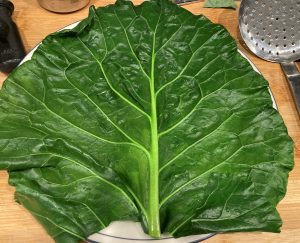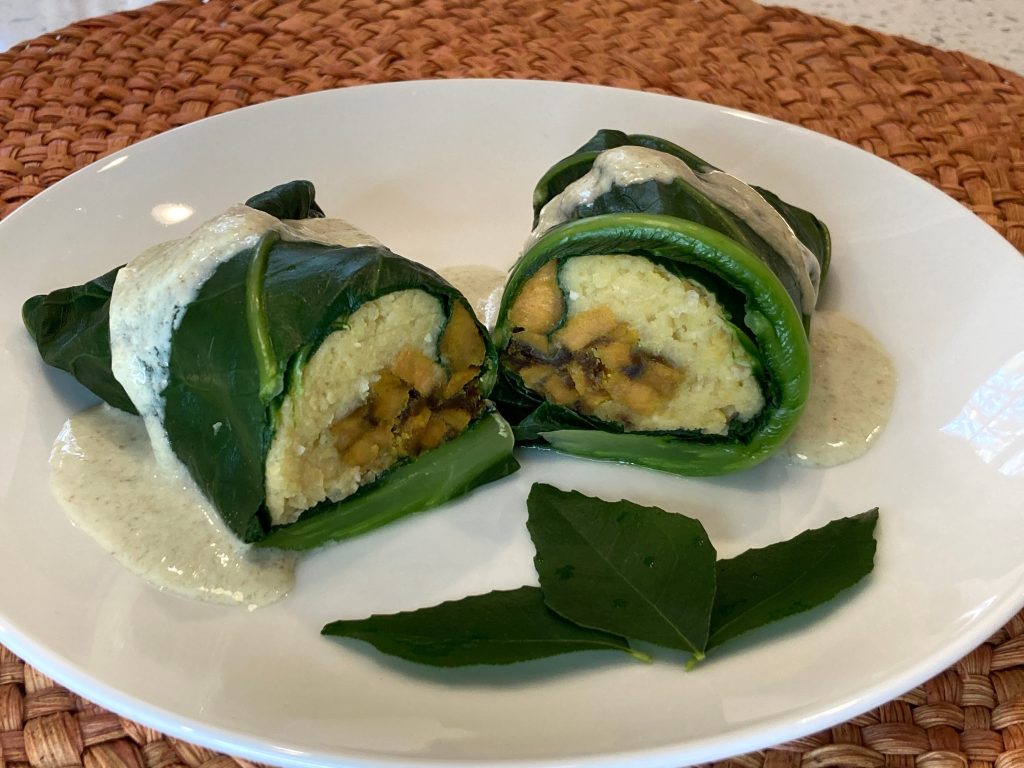SAVORY VEGETABLE ROLLS or
ROOT VEGETABLE CASSEROLE
If you avoid legumes, you can substitute polenta, bread stuffing, or mashed potatoes for the chickpeas as your first layer in the rolls or casserole. Whatever greens you choose, you want them to cook until tender enough to roll and also tender enough to slice through when served.
For the rolls
8 to 12 Swiss Chard or collard leaves
3 cups chickpea hummus, homemade or prepared
3 cups vegetable filling (see two options below)
1 to 2 cups sauce
Directions for assembling the rolls after making the chickpeas and vegetable filling are below.
For the homemade chickpea hummus
2 cups dried chickpeas (garbanzo beans)
½ cup extra virgin olive oil
½ cup reserved chickpea water
2 large garlic cloves
or 2 teaspoons freshly grated ginger
1½ to 2 teaspoons mineral salt
1. Soak the chickpeas overnight. Rinse and strain them a few times. In a standard pressure cooker, add 6 cups of water to the chickpeas, and bring the cooker to full pressure on high heat. Gently move the pot to a cool burner and allow the steam to release naturally. When it is safe to remove the lid, pierce a chickpea and test its softness. If the peas are even a little bit hard, recover and cook without pressure on medium heat until the peas are quite tender. Strain the chickpeas and allow them to cool for at least 10 minutes.
In an Instant Pot, cook with 5 cups of water on the beans setting with high pressure for 30 minutes. Let the steam release naturally. When the pot is ready to open, strain the chickpeas into a stainless steel bowl so you can save the cooking water for use later in this recipe (and for the root vegetable recipe below). Let the chickpeas cool in the strainer for at least 10 minutes.
2. Put all the ingredients in a food processor or blender and process until the mixture is completely smooth. You may want to add a little more oil, water, or salt to get to the right texture. Note: It will roll more easily if the mixture is somewhat thicker than store-bought hummus.
VEGETABLE FILLING OPTIONS
For savory sweet potato filling
Note: This recipe takes less time than the root vegetable filling, below. Vegetarian readers may want to cook the fillings with ghee.
1 medium sweet onion
2 tablespoons avocado or coconut oil
2 large sweet potatoes
1½ teaspoons ground cumin
1 teaspoon ground coriander
1 teaspoon ground turmeric
¼ to ½ teaspoon garam masala
1 teaspoon mineral salt, or more, to taste
1. Finely dice the onion. Warm a large sauté pan on medium heat. Add the oil and the diced onion and stir occasionally until the onion turns golden and begins to brown. Reduce heat to medium low and continue to cook.
2. While the diced onion is cooking, peel the slice the potatoes. Add the cumin, coriander, turmeric and garam masala to the pan and stir for about 15 seconds. Then add the sliced potatoes with salt and a couple tablespoons of water. Cover and cook for about 15 minutes or until the potatoes are tender. Stir occasionally.
For root vegetable filling
1 large sweet onion
2 tablespoons avocado oil or coconut oil
4 to 6 large carrots
1 or 2 large parsnips
2 to 4 fennel stalks
1 medium potato, sweet or white
1 teaspoon ground cumin
½ teaspoon coriander
½ teaspoon turmeric
¼ teaspoon cinnamon or garam masala
1 cup Easy Vegetable Soup Stock
1 teaspoon mineral salt, or more, to taste
Time Saver: Although I love to use a good knife, this is the kind of dish when a food processor is most helpful!
1. Finely dice the onion. Warm a large sauté pan on medium heat. Add the oil and the diced onion, and stir occasionally until the onion turns golden and begins to brown. Reduce the heat to medium low and continue to let the onion slowly caramelize while you prepare the vegetables.
2. Wash and cut the carrots and parsnips lengthwise before slicing thinly or processing. Slice the fennel stalks. Peel the potato and slice lengthwise in ¼-inch strips; then dice or process.
3. Add the spices to the pan and stir for about 15 seconds. Add the chopped vegetables to the pan along with the soup stock and salt. Cook for about 15 minutes until the vegetables are tender and the stock is completely absorbed. Add salt to taste.
SAUCE OPTIONS
Curry Leaf Chutney
Recipe by Vaidya Smita Naram
10 fresh curry leaves
¼ cup raw almonds
1½- to 2-inch piece of ginger, peeled
½ to 1 cup water, according to preference
1 cup tightly packed fresh cilantro, washed
¼ teaspoon Fine Ground Celtic Sea Salt
2 teaspoons fresh lime juice, or more, to taste
Note: Most people love this chutney, which is like a wonderful sauce, so you may want to double the recipe and have extra available for serving at the table.
1. Put all the ingredients in a Vitamix or blender, and process. (If you have a regular blender, you may want to grate the ginger before blending.)
2. If you hand chop all the ingredients before adding water, you will have a chunkier sauce, and that’s fine.
Shiitake Mushroom Sauce
¼ to ½ pound shiitake mushrooms
2 tablespoons avocado or coconut oil
1 leek bulb, sliced thinly, plus 1 inch of green stalk
½ cup white wine (optional)
1 cup chickpea cooking water or plain water
2 cups plain almond milk, separated (freshly made, if possible)
2 teaspoons fresh thyme leaves
1 teaspoon fresh rosemary leaves, chopped
1 teaspoon freshly grated ginger
1 tablespoon arrowroot
½ cup finely chopped walnuts, almonds, or pistachios
½ to 1 teaspoon mineral salt
dash of black pepper
1. Wash the mushrooms and pat dry. Remove the stems and set aside for another use. Chop the mushroom caps or process in a food processor so the mushrooms are very finely chopped.
2. Wash and slice the leeks. Heat a medium saucepan (preferably with a spout) on medium heat. Sauté the leeks in oil until they turn golden, then add wine and mushrooms. Once the wine starts to simmer, turn the heat to medium-low and let it cook, uncovered, for about 10 minutes until the wine cooks off. Add the chickpea cooking water, 1½ cups of the almond milk, thyme, rosemary, and ginger. Raise the heat to medium high, stirring occasionally until the sauce starts steaming. Then reduce the heat back to medium-low.
3. Place the arrowroot in a small cup or dish with the remaining ½ cup of cold almond milk and combine with a fine whisk to stir out the lumps. Add the arrowroot mixture to the sauce and stir well for about 3 minutes until the sauce thickens. Stir in the nuts, salt, and black pepper. Taste and, if needed, add salt. Let the sauce stay on low heat to remain warm if you’re serving it soon. (Otherwise, set aside and reheat later.)

Collard leaves are larger and easier to handle, so they are more impressive if you have the time and patience to blanch them until tender.
Prepare to Assemble the Rolls
1. Bring 8 cups (2 quarts) of water to a boil in a soup pot. Prepare a large mixing bowl with several cups of water and ice. Oil a casserole dish with avocado or coconut oil. If you plan to serve the chard rolls shortly after assembling them, preheat the oven to 350°F.
2. Slice the bottom ¼-inch off each chard leaf to remove the hard red stem so that it will be easier to roll. Then, one at a time, dip each chard leaf into the boiling water for 30 to 40 seconds. Remove and plunge the leaf into ice water for 5 seconds. Shake any excess water off the leaf and drain it on a paper towel. Once the leaves have been prepared, set up an assembly line with the leaves, chickpea mixture, and vegetable stuffing. Working one leaf at a time, place a leaf on a plate or board, put ½ cup of the chickpea mixture at the large base of the leaf’s triangle (or optional layer of polenta or mashed potatoes), forming the mixture into a small log. (If you have small leaves, use only ¼ cup of the chickpea mixture in each leaf.) Place about 2 to 4 tablespoons of vegetables over the chickpeas. Then roll upward from the base, tucking the sides as you go. Place the rolls in the casserole dish, one by one, and congratulate yourself when you’ve finished!
3. Cover the dish and heat the rolls in the oven for 30 minutes. Serve the rolls with a generous portion of mushroom sauce.
Variation: Assemble a Casserole
If you want to save time and make a casserole version of this dish, you can either blanch the greens prior to assembly or chop the leaves into strips, and steam them until tender, about 10 minutes. Layer the casserole starting with sauce on the bottom, followed by the chickpea mixture (or optional layer such as polenta or mashed potatoes), greens, vegetable stuffing, and finish with a layer of sauce. (You may want to double your sauce recipe for a casserole.) Sprinkle some fresh minced parsley across the top, if you wish. Bake for 30 minutes or until the casserole is heated all the way through. Serve immediately.
Mushrooms increase vata so increase the fresh ginger to 2 teaspoons. Also, increase black pepper.






